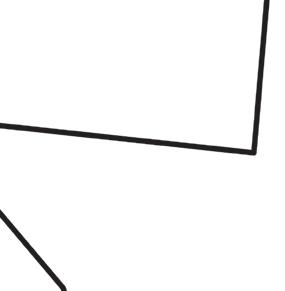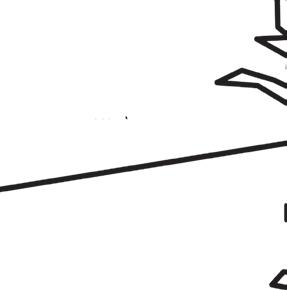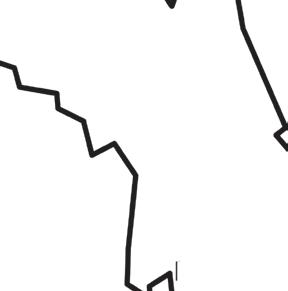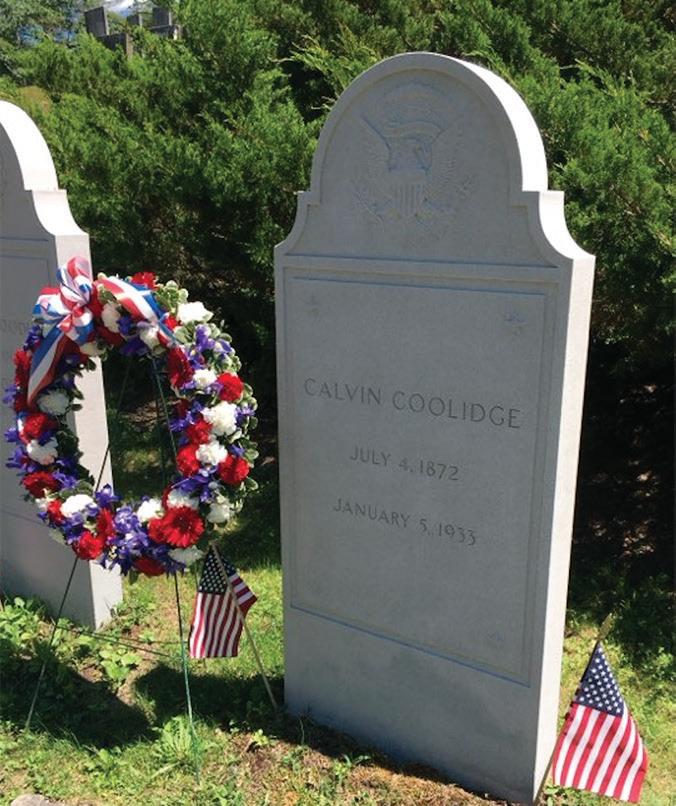A History Teacher’s FIFTY YEAR QUEST TO Visit Every President’s Grave
RUSSELL BECKMAN
when my new friend’s dad smiled, shook my hand, and told me I was “shaking the hand that shook the hand that shook the hand of Abraham Lincoln,” he asked me if I understood what he meant. It was the 1970s, I was in middle school. With some thought, I was able to sort out what he was saying, but it took me many years to fully understand his point and to realize that his handshake would mark the start of a nearly fifty-year journey. I would soon develop a yearning to feel connected to the former presidents I was learning about in school, and by the time I was in my twenties I was on a quest to visit every deceased president’s grave. Fulfilling my goal has taken me to nineteen states, from Calvin Coolidge’s rural grave in idyllic Plymouth Notch, Vermont, to the graves of Ronald Reagan and Richard Nixon outside of the congested city of Los Angeles, California. I have now visited the final resting sites of all the presidents except that of President Jimmy Carter, who passed away at age 100 earlier this year. As this issue goes to press in June 2025, the Carter gravesite has not yet opened to the public.

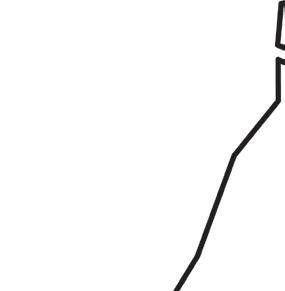


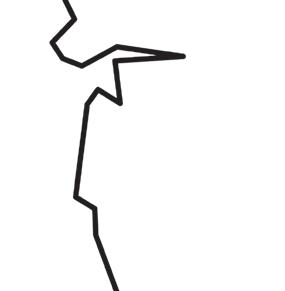

1. George Washington
Mount Vernon estate
Mount Vernon, Virginia
2. John Adams
United First Parish Church
Quincy, Massachusetts
3. Thomas Jefferson Monticello estate Charlottesville, Virginia
4. James Madison Montpelier estate Montpelier Station, Virginia
5. James Monroe Hollywood Cemetery Richmond, Virginia
6. John Quincy Adams United First Parish Church Quincy, Massachusetts
7. Andrew Jackson
The Hermitage estate Nashville, Tennessee
8. Martin Van Buren
10. John Tyler Hollywood Cemetery Richmond, Virginia
11. James K. Polk Tennessee State Capitol Nashville, Tennessee
12. Zachary Taylor Zachary Taylor National Cemetery Louisville, Kentucky
13. Millard Fillmore Forest Lawn Cemetery Buffalo, New York
16. Abraham Lincoln Oak Ridge Cemetery Springfield, Illinois
17. Andrew Johnson Andrew Johnson National Cemetery Greeneville, Tennessee
Reformed Dutch Church Cemetery Kinderhook, New York
9. William Henry Harrison William Henry Harrison Memorial North Bend, Ohio
14. Franklin Pierce Old North Cemetery Concord, New Hampshire
15. James Buchanan Woodward Hill Cemetery Lancaster, Pennsylvania
18. Ulysses S. Grant General Grant National Memorial New York, New York
19. Rutherford B. Hayes Spiegel Grove estate Fremont, Ohio
20. James A. Garfield James A. Garfield Memorial Cleveland, Ohio
21. Chester Arthur Albany Rural Cemetery Albany, New York
22 & 24. Grover Cleveland Princeton Cemetery Princeton, New Jersey
23. Benjamin Harrison Crown Hill Cemetery Indianapolis, Indiana
GRAVE SITES of the U.S. PRESIDENTS
7 1 5 3 4 26 9 8
25. William McKinley William McKinley Memorial Canton, Ohio
35. John F. Kennedy Arlington National Cemetery Arlington, Virginia
36. Lyndon B. Johnson Lyndon B. Johnson National Historical Park Stonewall, Texas
31. Herbert Hoover Herbert Hoover Presidential Site and Museum West Branch, Iowa
32. Franklin Roosevelt Springwood estate Hyde Park, New York
37. Richard Nixon Richard Nixon Presidential Library and Museum Yorba Linda, California
38. Gerald Ford Gerald R. Ford Presidential Museum Grand Rapids, Michigan
26. Theodore Roosevelt Youngs Memorial Cemetery Oyster Bay, New York
27. William Howard Taft Arlington National Cemetery Arlington, Virginia
28. Woodrow Wilson Washington National Cathedral Washington, D.C.
33. Harry S. Truman Woodlawn Cemetery Independence, Missouri
39. Jimmy Carter Jimmy Carter National Historical Park Plains, Georgia
29. Warren G. Harding Harding Memorial Presidential Grave Site Marion, Ohio
30. Calvin Coolidge Plymouth Notch Cemetery Plymouth Notch, Vermont
34. Dwight Eisenhower Eisenhower Presidential Library and Museum Abilene, Kansas
41. George H. W. Bush
40. Ronald Reagan Ronald Reagan Presidential Library Simi Valley, California
George H. W. Bush Presidential Library and Museum College Station, Texas
Once I became an adult, tackling my goal of visiting all the presidential graves slowly picked up steam. I eventually became a teacher, and I shared my enthusiasm with my students. But the ambitious journey also had to take a backseat to the regular ebbs and flows of life. There were fits and starts over decades. Bills were paid, children were raised, parents and other loved ones died. The daily mundane toil of the circle of life never ceased. But year after year, I devoted some time to make progress toward completing my personal quest.
To me each visit to a presidential grave was a personal encounter. To prepare, I studied the president’s strengths, weaknesses, the manner in which he governed, and the challenges he faced. I usually visited the grave site alone, reflecting on the president’s life. I shared my thoughts with him, as if having a conversation, and I felt a connection to him. That is what I wanted.
VIRGINIA
Seven presidents are buried in Virginia, more than any other state. And it was at Arlington National Cemetery in Virginia where I began my journey with a visit to the grave site of President John F. Kennedy in the early 1980s. I often returned to this site during the many years I had the privilege of serving as a chaperone for a Wisconsin law enforcement organization that sponsored student field trips to Washington, D.C. For me the trips were expenses-paid, nonstop history-seeking fun, which intensified my passion for history. In those pre-9/11 days, our group was usually able to arrange to tour the public areas of the White House. Although I had to focus my attention on supervising my young charges as we walked through the White House, I was still able to reflect on the lives lived there, giving context to my graveside visits. opening spread
The author visits the grave of President Abraham Lincoln in Springfield, Illinois. below
The remains of President George Washington are housed within a tomb on his Mount Vernon estate in Virginia.
Seven presidents are buried in Virginia. John Tyler’s grave (left) is one of two in the historic Hollywood Cemetery in Richmond. The other is James Monroe. Like George Washington, James Madison and Thomas Jefferson are buried on their estates. Madison’s grave is at Montpelier in Orange County (center), and Jefferson’s (right) is at Monticello near Charlottesville.
Of course, each of these trips included Arlington National Cemetery. As our group stood near the eternal flame of President Kennedy’s grave, I would tell our students that while standing in front of Arlington House in the days before his death, President Kennedy was heard saying that he could take in the majestic view “forever,” to add to their understanding of why the president rested here. Before leaving the cemetery, I would be sure that our group would also visit the often-overlooked grave of President William Howard Taft, a short walk from President Kennedy’s grave. We would then travel on to Mount Vernon, where we would visit the grave of President George Washington. This visit allowed our budding historians to get three presidential graves into their experience portfolios before they were old enough to drive.
Although serving as a de facto tour guide to the middle schoolers had its own important value, the group visits lacked the intimacy I found on my solo visits to presidential graves.
My travels through Virginia would eventually take me to Hollywood Cemetery in Richmond, where I visited the graves of James Monroe and John Tyler, to Thomas Jefferson’s grave at Monticello, and to James Madison’s grave at Montpelier.
OHIO
Five of my presidential encounters occurred in Ohio at the grave sites of William Henry Harrison, Rutherford B. Hayes, James A. Garfield, William McKinley, and Warren G. Harding. Since the 1980s I have driven the Ohio Turnpike in the northern portion of the state many timess, often stopping at the graves of Hayes, McKinley, and Garfield. Many presidential resting places are majestic and opulent, and the memorials to the two Ohio presidents who lost their lives to assassin’s bullets are striking examples of this. When I visited President McKinley’s mausoleum in Canton, Ohio, I became winded climbing the 108 wide and long steps that lead from the ground to the entrance of the enormous memorial
set atop a hill. It was an unseasonably cold mid-April day in 2014. Light snow was falling and, being from Wisconsin, I could not help but think the architect of this grand structure must have been oblivious to the fact that these steps would need to be cleared of snow long into eternity.
Just down the road in Cleveland, the sootstained stone of President James Garfield’s opulent final quarters in Lake View Cemetery epitomizes the Gilded Age. The darkened stone led me to assume the monument was built downwind from an oil refinery or steel mill. I suspect that it was a century plus of exposure to pollutants that coated the exterior of Garfield’s structure, and all the other stones in that cemetery, with a blackened sheen.
Two of the largest presidential memorials are found in Ohio and honor two assassinated presidents. President William McKinley is interred in a hilltop mausoleum in Canton, and a crypt within a towering memorial in Cleveland holds the remains of President James Garfield.
MID-ATLANTIC
In contrast to the McKinley and Garfield memorials, there are also very ordinary presidential graves. President Buchanan’s grave in Lancaster, Pennsylvania, was so austere that it took some time to find among the similar headstones that populated Woodward Hill Cemetery. It was the same with the graves of Franklin Pierce in Concord, New Hampshire, and Grover Cleveland in Princeton, New Jersey. Generations of urban sprawl had encroached upon their cemeteries, putting their graves within a stone’s throw of recent residential developments.
NEW YORK
Over time, I visited the graves of six presidents in New York: Chester A. Arthur, Martin Van Buren, Millard Fillmore, Ulysses S. Grant, Franklin D. Roosevelt, and Theodore Roosevelt. Heavy fog shrouded the waters of Oyster Bay Cove on New York’s Long Island as I stood near President Theodore Roosevelt’s final outpost on a hill. I climbed the long staircase under a canopy of large mature trees and over a plush carpet of wet golden leaves on that dismal fall day to meet with him. During my imaginary intellectual conversation with TR, I got the sense he was pleased with the magnificent view of the cove that the fog was not permitting me to see for myself.
Years earlier, I spent a wonderful day with one of my daughters to check in with Chester Arthur, Martin Van Buren, and Franklin Roosevelt on a day-long road trip through the Hudson River Valley. That awesome day, which could warrant its own separate essay, ended with dinner at the Culinary Institute of America in Hyde Park, New York.
TENNESSEE
During parts of my journey, it was necessary to move along quickly. This happened on a trip across the wide state of Tennessee to visit the graves of Andrew Jackson and James K. Polk in Nashville, ahead of driving four hours east to Greeneville, Tennessee where I would stop at the grave of President Andrew Johnson.
Most respectable cemeteries close at sunset or early evening. On that late fall day, I beat the dusk closing time and was able to enjoy a colorful sunset with President Andrew Johnson at his grave high atop Monument Hill in Greeneville. As the sun was setting, I sensed a subtle giddiness from Johnson. After the passing of more than a century, he was no longer the only impeached president.
left
President James Buchanan’s grave is in the Woodward Hill Cemetery in Lancaster, Pennsylvania.
opposite
President Andrew Johnson personally selected his burial site within view of the mountains on Signal Hill (now Monument Hill) in Greeneville, Tennessee. The site is now a part of the Andrew Johnson National Cemetery.
opposite
The crypt in the basement of the United First Parish Church in Quincy, Massachusetts, holds the remains of two presidents, John Adams and his son John Quincy Adams. They were first interred in Hancock Cemetery just across the street.
below
President Gerald R. Ford is buried beside his wife Betty at the Gerald R. Ford Presidential Museum in Grand Rapids, Michigan.
Calvin Coolidge’s tombstone in Plymouth Notch, Vermont, though embellished with the eagle of presidential seal, is among the simplest of all presidential grave markers.
MICHIGAN
The same sun was glowing on an early August morning when I took the Lake Express Ferry east from Milwaukee on a two-and-one-half-hour journey across Lake Michigan to Muskegon, Michigan. From there, I drove to Grand Rapids to visit the grave of President Gerald R. Ford on the banks of the Grand River. When I was with President Ford, I sensed he was at peace with his decision to pardon President Nixon.
NEW ENGLAND
On my trip to Massachusetts, I visited father and son presidents, John and John Quincy Adams who lay with their first ladies in four large tombs in a small basement crypt of the United First Parish Church in Quincy. I imagined the dirt streets and simpler wooden structures that once surrounded this old church as I walked past the trendy coffee shops and bistros that now occupy the storefronts of the newer buildings in the neighborhood.
I spent some time with both presidents and their first ladies and sensed they were proud of their families and of their community’s contribution to the formation of our country. I felt them encouraging me to visit Hancock Cemetery across the small plaza in front of the church, where both couples were interred before their remains were moved into the church. Many generations of the Adams family still rest in that colonial-era cemetery.
Once at Hancock Cemetery I paused to consider how blessed I am to enjoy the freedom that was paid for by the sacrifices of so many as I stood at a marker placed in 1923 by the Adams Chapter of the Daughters of the Americam Revolution and the City of Quincy. This marker listed fifty men from Quincy who died in the American Revolutionary War. Six Quincy families lost three or more men. I wondered if they would be pleased with what the country for which their family’s blood was shed has become.
Since I am from Wisconsin, President Calvin Coolidge’s grave and hometown of Plymouth Notch, Vermont, was far off my beaten path until two of my three children chose to attend college at Syracuse University in upstate New York and my son later lived and worked in Binghamton, New York. This allowed me to use his Binghamton home as a base to visit Coolidge’s grave. Before dawn on an early July morning, I started my nearly 500 mile round trip drive to Plymouth Notch. The drive was scenic and reminded me of the rugged Upper Peninsula of Michigan, one of my frequent haunts. I was uplifted when I saw the “Moose Crossing” signs as I drove through Green Mountain National Forest.
I found Coolige’s grave, positioned on the second level of a tiered hillside, was much like him, unassuming and austere. I wondered if growing up in such a rural and remote place contributed to making “Silent Cal” a man of few words. All of us are products of our environment.
TEXAS
I waited many years to visit the grave of President Lyndon Johnson in Stonewall, Texas. I waited, somewhat ghoulishly, until after the death of President George H. W. Bush. It was known that Bush and his first lady, Barbara Bush, were going to be buried at the George H. W. Bush Presidential Library and Museum on the campus of Texas A&M University in College Station. I decided that once President Bush was laid to rest, I could visit both his and President Johnson’s grave in one trip. I made this trip in December 2019 when there were only four presidential grave sites left to mark off my list.
I flew into Dallas Fort Worth International Airport. Since I was in Texas, I picked out the newest and biggest pickup truck from the array of choices my rental car company offered. Sometimes you want to blend in with the locals.
Before I headed south to College Station, my first stop was the Texas School Book Depository, the site from which the shot was fired that killed President Kennedy. The Sixth Floor Museum is must stop for anyone interested in American history.
I arrived at President George H. W. Bush’s Library early enough the next morning to walk alone on the path to his and Mrs. Bush’s final resting spot. As I enjoyed the early morning solitude, I thought back to the September 11, 2001, terrorist attacks when his son was the president who was confronted by this horrific challenge. As a father of three wonderful young adults, I contemplated how difficult that day must have been for him. I also remembered that he and Mrs. Bush 41 were on a commercial flight from Washington, D.C., to Minneapolis at the time of the attacks. Their flight, like all other civilian air traffic, was ordered to land at the closest airport, and that was Milwaukee, where later that afternoon they happened to take a walk in a suburban golf course. My father-in-law was in a small group that encountered the Bushes there. He spoke to President Bush who autographed a blank score card from the golf course. I later framed the score card along with my fatherin-law’s written description of the event. Before he passed away, he gave it to me, and it remains one of my most prized possessions.
below
A low stone wall surrounds the site where President and Mrs. Lyndon Johnson are buried with generations of the Johnson family in the Texas Hill Country near Austin.
opposite
An enclosed area on the grounds of the George H. W. Bush Presidential Library holds the graves of President George H. W. Bush, First Lady Barbara Bush, and their daughter, Pauline Robinson (“Robin”) Bush.
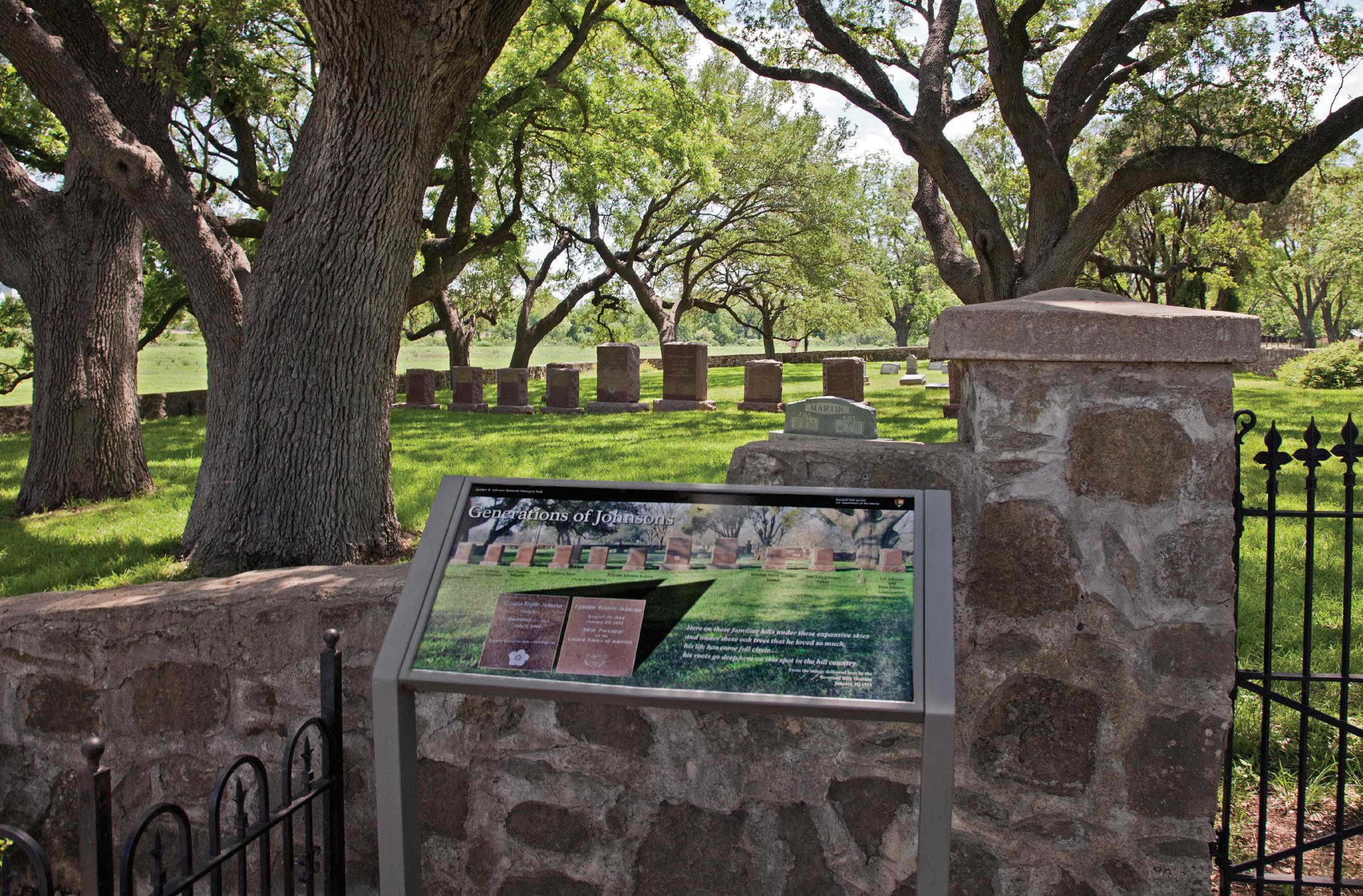
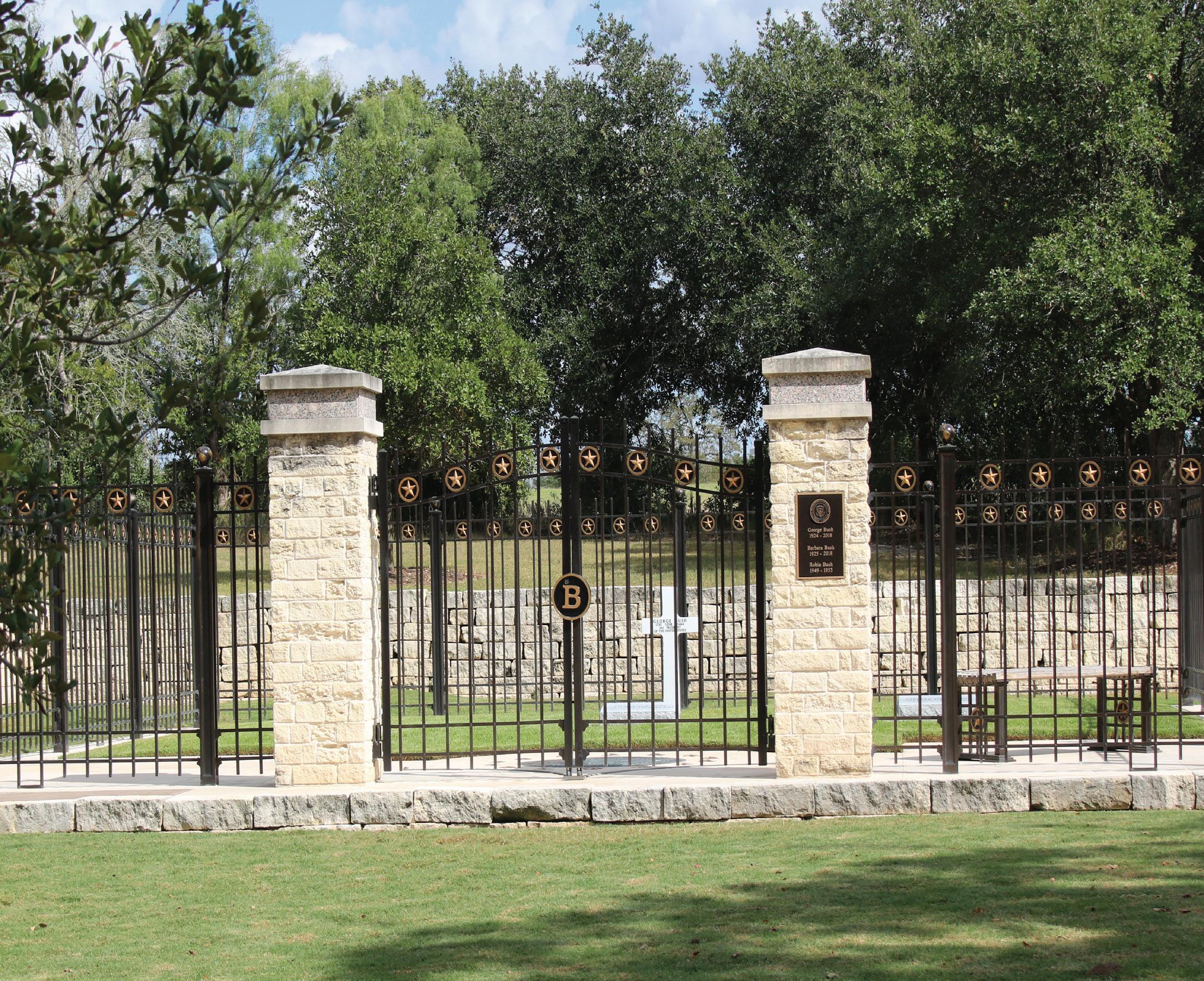
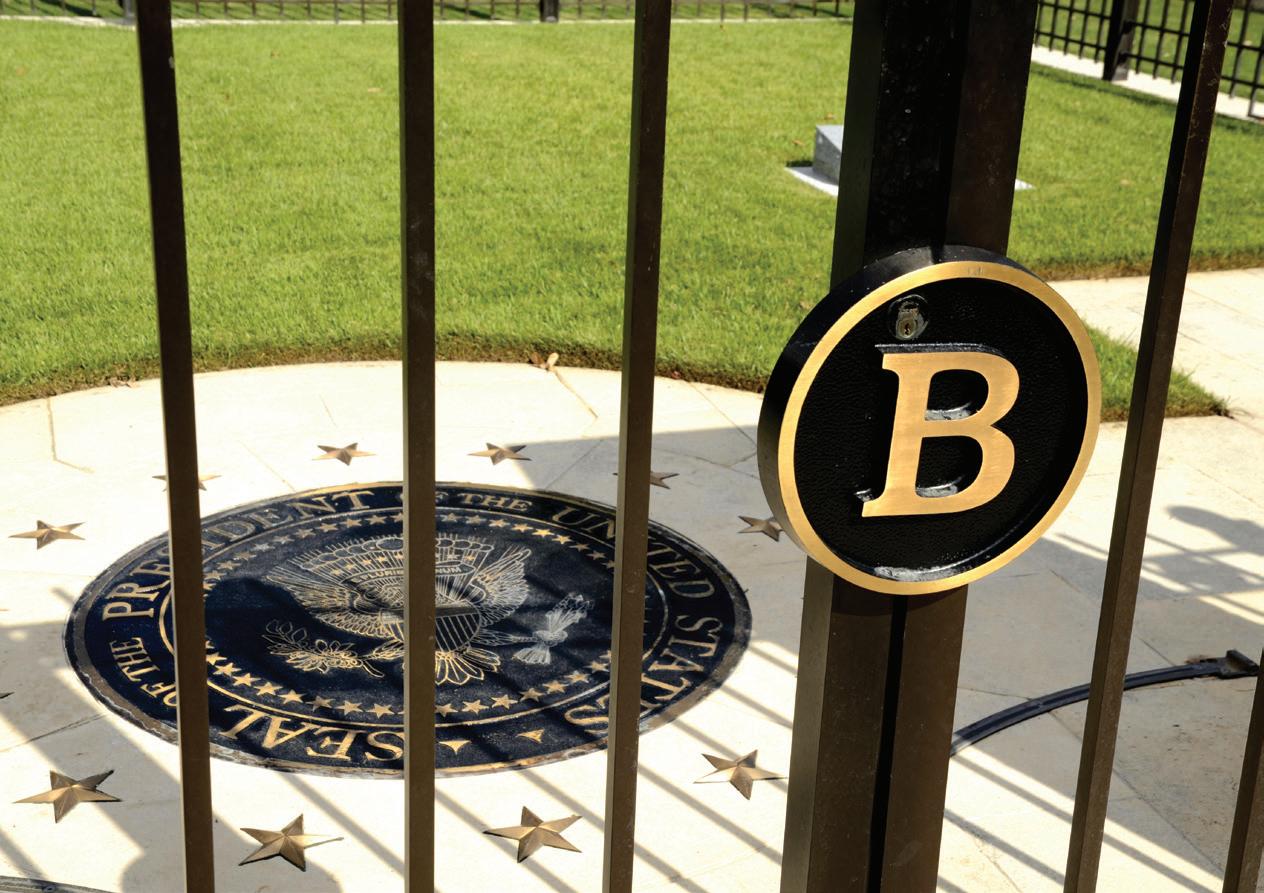
The next day, after a long drive to the Texas Hill Country, I visited the Lyndon B. Johnson National Historical Park. Before Johnson entered politics, he was a schoolteacher. As a teacher myself, I felt especially connected to him. I stopped at the one-room Junction School, which LBJ attended from age four and which inspired his interest in public education as the historical marker indicates. I was also able to sit at a table placed at the spot outside this school where he signed the landmark Elementary and Secondary Education Act of 1965. I then took the short walk to the cemetery where Johnson and many generations of his family rest. Respecting the boundary of the low stone wall surrounding the site, I was able to view Johnson’s brown-colored stone marker from a distance before I started my long return drive back to Dallas.
CALIFORNIA
Growing up, I had a big interest in following the news and actually read the newspapers I delivered to my neighbors. I watched as President Richard M. Nixon announced his resignation to the nation on August 8, 1974, and I tuned in again the following day to watch as he said good-bye to his assembled staff in the East Room and walked across the South Lawn to Marine One. Before boarding, he turned to the crowd, smiled, waved, and, somewhat defiantly, gave the double peace sign in his unique animated way.
Admittedly, at age 12, I did not grasp the personal relevance of Nixon’s farewell speech to his administrative staff. But later in my life, when I faced challenging personal issues, it sunk in. His words, “Only if you have been in the deepest valley can you ever know how magnificent it is to be on the highest mountain” became an important inspiration for me, and today I share those words with my at-risk students, all of whom face major challenges in their young lives. When I visited Nixon’s grave site in Yorba Linda, California, I thanked him and sensed my thought brought him some joy. As I sat with him, I felt he was at peace.
Marine One was also on exhibit nearby, a powerful symbol of the transition in his life that took place in front of the world. I was able to sit inside the helicopter and imagine Nixon’s thoughts as it carried him away from the White House. The study of Nixon’s life and words has helped me connect with my students. I tell my students that Nixon
helped me to understand unless you suffer from despair, you can never fully appreciate joy. Having that wisdom fostered hope for me. Maybe it will for them.
The day after I visited President Nixon, I found myself driving up the winding road to the Ronald Reagan Presidential Library and Museum in Simi Valley, California. I walked through the exhibits and lingered inside the Boeing 707 that served as Air Force One during the Reagan and several other
left and below
while
the
site of
The author prepares to take a selfie
visiting
grave
President Richard M. Nixon. Nixon is buried beside his wife Pat near his childhood home on the grounds of the Richard M. Nixon Presidential Library and Museum in Yorba Linda, California.
below
President Woodrow Wilson’s is interred in Washington National Cathedral.
presidencies, which is displayed inside the museum. Once outside in the wonderful California sunshine, I made my way to the final resting place of President Reagan and his first lady, Nancy Reagan. As I stood at the grave, I felt like I had been there before. My thoughts returned to June 11, 2004, when along with millions of Americans, I watched the live television coverage of Reagan’s funeral. I remember watching Mrs. Reagan sitting near the the president’s casket as the honor guard folded the flag and presented it to her, and how she kissed the casket in a most dignified manner, bidding her husband a final good-bye. This poignant display of genuine love occurred in the golden light of the sun setting over the Santa Monica Mountains and the Pacific Ocean.
MIDWEST
The graves I have visited most recently are those of Dwight D. Eisenhower and Harry S. Truman in the Midwest. But COVID-19 delayed my journey. Once the virus numbers declined and the sites reopened, I was able to stand at their tombs.
My previous trips in my midwest backyard had taken me to visit Abraham Lincoln in Springfield, Illinois; Herbert Hoover in West Branch, Iowa; Benjamin Harrison in Indianapolis, Indiana; and just south of the Ohio River, Zachary Taylor in Louisville, Kentucky.
WASHINGTON, D.C.
Only one president is buried in Washington, D.C., Woodrow Wilson, who is interred within the nave of Washington National Cathedral. On a sunny day, his crypt is bathed in the colorful light filtered by the stunning stained-glass windows. I have visited President Wilson many times over the past several decades, and the cathedral itself is one of my favorite places in the District of Columbia.
FINAL THOUGHTS
Most of the presidential graves are under the control of the National Park Service, National Archives, or a private nonprofit historical organization. At most sites, I would find a friendly ranger or guide willing to share knowledge. In some of these talks, I learned that many others are on a similar journey. I was not surprised since I am not the only person who prefers collecting experiences over collecting things.
Now that the quest is nearly done for me, I can reflect on what I did and why it matters. I know I may never get to visit the grave of a female president, but I believe the day is coming when a woman will hold the office. I also think about one of the anthems of my life, “Dust in the Wind,” by Kansas. No matter how important or obscure, every one of us becomes the dust in the wind, even the leader of the free world. As I stood with each president, I reflected on his legacy and the legacy I will leave. As a teacher, if I do my job well, my impact could be significant.
My life’s journey, including my connection with each of my country’s presidents, has helped me to be a better history teacher for my students. I get a sense of joy when we talk about our connections to the past.
I also fully understand the joy my friend’s father felt when he shared his connection with President Lincoln back in my early teens. I hope my students see my enthusiasm as we explore the past, and I pray it helps them appreciate our nation’s heritage and provides a foundation upon which they can build a strong and prosperous future for themselves and for all of us.



























































